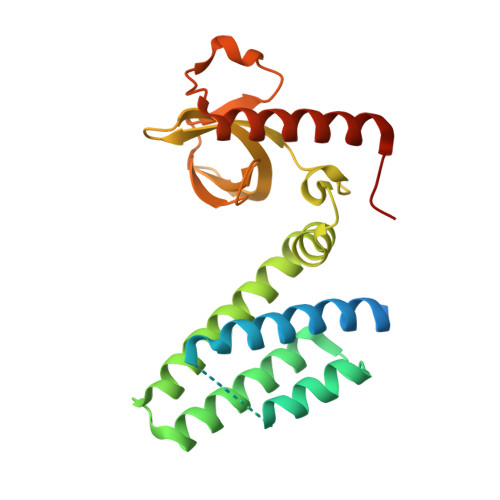ZMYND11 links histone H3.3K36me3 to transcription elongation and tumour suppression
Wen, H., Li, Y., Xi, Y., Jiang, S., Stratton, S., Peng, D., Tanaka, K., Ren, Y., Xia, Z., Wu, J., Li, B., Barton, M.C., Li, W., Li, H., Shi, X.(2014) Nature 508: 263-268
- PubMed: 24590075
- DOI: https://doi.org/10.1038/nature13045
- Primary Citation of Related Structures:
4N4G, 4N4H, 4N4I - PubMed Abstract:
Recognition of modified histones by 'reader' proteins plays a critical role in the regulation of chromatin. H3K36 trimethylation (H3K36me3) is deposited onto the nucleosomes in the transcribed regions after RNA polymerase II elongation. In yeast, this mark in turn recruits epigenetic regulators to reset the chromatin to a relatively repressive state, thus suppressing cryptic transcription. However, much less is known about the role of H3K36me3 in transcription regulation in mammals. This is further complicated by the transcription-coupled incorporation of the histone variant H3.3 in gene bodies. Here we show that the candidate tumour suppressor ZMYND11 specifically recognizes H3K36me3 on H3.3 (H3.3K36me3) and regulates RNA polymerase II elongation. Structural studies show that in addition to the trimethyl-lysine binding by an aromatic cage within the PWWP domain, the H3.3-dependent recognition is mediated by the encapsulation of the H3.3-specific 'Ser 31' residue in a composite pocket formed by the tandem bromo-PWWP domains of ZMYND11. Chromatin immunoprecipitation followed by sequencing shows a genome-wide co-localization of ZMYND11 with H3K36me3 and H3.3 in gene bodies, and its occupancy requires the pre-deposition of H3.3K36me3. Although ZMYND11 is associated with highly expressed genes, it functions as an unconventional transcription co-repressor by modulating RNA polymerase II at the elongation stage. ZMYND11 is critical for the repression of a transcriptional program that is essential for tumour cell growth; low expression levels of ZMYND11 in breast cancer patients correlate with worse prognosis. Consistently, overexpression of ZMYND11 suppresses cancer cell growth in vitro and tumour formation in mice. Together, this study identifies ZMYND11 as an H3.3-specific reader of H3K36me3 that links the histone-variant-mediated transcription elongation control to tumour suppression.
- 1] Department of Biochemistry and Molecular Biology, The University of Texas MD Anderson Cancer Center, Houston, Texas 77030, USA [2] Center for Cancer Epigenetics, Center for Genetics and Genomics, and Center for Stem Cell and Developmental Biology, The University of Texas MD Anderson Cancer Center, Houston, Texas 77030, USA [3].
Organizational Affiliation:





















